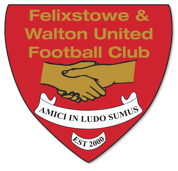Remembering the Old Pavilion

Remembering the Old Pavilion - Article By Barry Grossmith and contribution by Dave Ashford (President).
The very first game I saw at The Goldstar Ground was Felixstowe & Walton United at home to Gorleston FC in 2017. I came down Dellwood Avenue and the first sight to greet me inside the ground was The Old Cricket Pavilion. It was half an hour before kick off and time for a pre-match pint. What I didn’t know when I went up to the bar was any of the history the Old Edwardian Pavilion had to offer.
I didn’t know at the time that a new clubhouse was going to be built. I didn’t even know what colours The Seasiders played in! As I left the Pavilion 10 minutes before kick off I walked up to the turnstile and saw roped off areas and diggers that told me building of some sort was under way.
By the time I left the ground around 5 o’clock I’d learnt quite a bit. I’d learnt that Felixstowe played in red & white, I’d learnt that the team was quite good having just walloped Gorleston 6-0, I’d learnt that the people I spoke to that day were all very friendly and welcoming and I’d learnt that a new clubhouse was being built to replace the fine old building that had served me my very first pint at the Goldstar Ground.
Now, 16 months later I have had the honour of discovering what an interesting history The Old Pavilion holds and how many stories are there to be told by people at the club who now are nearly as old as the Pavilion itself! Now that, of course is a massive exaggeration as the Pavilion is at least 100 years old.
Much of what I’ve discovered has come my way from Club President Dave Ashford whose connection with the club goes back to 1968 when he was reserve team manager prior to becoming first team manager from 1969 to 1977. Dave has held numerous positions at the club including those of Treasurer and Chairman.
 When I knew the Pavilion was about to be demolished I decided to write something about it for the website. I needed information and I needed stories. The plan then was to put an article together summarising everything I’d been told. As Dave started to provide all the information however, I soon realised that the best person to tell the story was, of course, Dave Ashford himself. Better to hear from someone who is part of the building’s history than from someone who is still a “new kid on the block”.
When I knew the Pavilion was about to be demolished I decided to write something about it for the website. I needed information and I needed stories. The plan then was to put an article together summarising everything I’d been told. As Dave started to provide all the information however, I soon realised that the best person to tell the story was, of course, Dave Ashford himself. Better to hear from someone who is part of the building’s history than from someone who is still a “new kid on the block”.
Dave, as some of you might know, is putting together a history of the football club. That is, of course, a massive undertaking. It does mean however that he has lots of notes he’s put together over the years. Around 1989 Dave wrote a few paragraphs about the pavilion and this has since been reprinted in a pamphlet entitled “A Brief History of The Old Pavilion, Felixstowe”. The pamphlet itself was produced and presented to VV Quintas FC our close friends from Holland who take part in the annual exchange visit with Felixstowe & Walton every year. In fact, the connection with Holland dates back to 1894 when Felixstowe Town FC visited and played against Sparta Rotterdam. But that’s another story so let’s return to The Old Pavilion.
Below I have reprinted the paragraph from the pamphlet in Dave’s own words:
During research into the area of the Town Ground when putting together Planning Applications for floodlights, we found the town map where the building is first shown in 1926. This Classical Edwardian Cricket Pavilion, built mainly of wood, served The Felixtowe Hockey Club, Felixstowe Cricket Club and Felixstowe Town Football Club over the years on a shared basis. The seasonal overlap did cause problems with the Football Club having to play most of the early season’s matches away from home due to cricket taking priority. The Pavilion at the time had the upstairs balcony on which the writer sat on many occasions himself whilst waiting to bat for the cricket club, or simply enjoying a beer! Upon the building of the other pavilion on the Town Ground in the early 1970s, the Old Pavilion was allowed to go into disrepair and was used as a store for lawnmowers, fertilisers and the like, used by the Groundsmen. During 1983, when The Eastern Counties League was insisting clubs brought their grounds more up to standard, with enclosed playing areas and railed off pitches, I approached the Suffolk Coastal District Council with the request that the football club be allowed to take over the refurbishment of the Old Pavilion and use the building as its exclusive headquarters. At the time I was unaware that this wonderful old building was within a few weeks of demolition, and whilst other parties had made tentative enquiries as to its future, the football club was positive in its approach. With the assistance of many local businesses, including Friends of Felixstowe, Fred Olsen Ltd and Specialised Fixings Ltd., and the wonderful work put in via the Suffolk Programmes Agency, supervised by John Lister, and site foreman, Stanley Markwell, club member David Sayers, the Pavilion was restored to its almost former glory, and has had extensive work done to provide showers for both teams and officials, and is as good as any other club’s facilities in the league. The plans for the alterations were done by yours truly, but I must thank the former Suffolk Coastal Council Surveyor Bob Banyard, who assisted me so much during the two years or so the work was being carried out. For Bob, I think the whole operation was a labour of love, and he made me promise not to do certain things to the building. His wishes were respected and it stands as a testament to those who were responsible in the refurbishment. In 1985, I negotiated a 21 year lease on the Pavilion and the pitch, and the future of the club is secured until 2006.
After reading the pamphlet I e-mailed Dave and asked him if he wouldn’t mind adding a few snippets to fill in the gaps. Fortunately Dave did more than simply add a few snippets. He got back to me with some fascinating history, which again I have reprinted below
In living memory, the home of the Town’s main football club, has always been, to the population of Felixstowe, situated on what was known as the Town Ground, Dellwood Avenue. The Classical Edwardian Cricket Pavilion has served the Town’s football club, and the Felixstowe Cricket and Hockey Clubs, as their dressing rooms for many years. The Pavilion has been used as a backdrop to many a team photograph for decades. The building is built mainly of wood throughout, and back in the late 1960’s when I first had occasion to use it, the facilities were very basic. There were two dressing rooms, one to the right, (eventually the kitchen), was the home dressing room, and to the left, an area which was to be transformed into the bar cellar, was the visitors changing room. There were wooden forms fitted around both dressing rooms, and an old fashioned hook for each player to hang his clothes. There was no heating whatsoever, a single bulb lit up each room, and the floors were bare. Outside the dressing rooms, but accessible to both teams, were the two showers, in an exact area which was taken up as the Bar in 1986, after refurbishment. The hot water for the showers was provided by a huge electric boiler, but players had to be quick if they wanted a hot shower, as once the tank was empty, the water ran cold ! A butler sink was provided to both dressing rooms, and only cold water was available from a single tap.
The main area was utilised during the soccer and hockey seasons, as changing rooms for two hockey teams and two football teams. There were two football pitches back then, the first team played in the area now the cricket outfield, and any other match was played on what is now the first team pitch.
All these people were accommodated by simply separating the space by curtains, to provide changing facilities. To the left of the building, at the end nearest the new facilities, was the Groundsmans’ area, where machinery and fertilisers were stored. There was no Bar or facility to provide food on site for visiting teams. Above the Pavilion was the Cricket scoreboard, with access by stairway from ground level, and a balcony from which a fine view of any Cricket in progress, could be enjoyed, during the summer months.
When games were over, there was no-where on site to socialise, and without floodlights, matches were over by 4pm. Pubs didn’t open due to Licensing hours until 5 or 530 pm, so players would get something to eat at say the Wimpy in town, before making their way to the infamous Station Buffet, which was situated on Felixstowe Town Station. This establishment was run by Ron and Sadie;- what a couple of characters they were! They made us very welcome and that small bar has seen some fantastic times. I estimate that sometimes we have had up to 70 people drinking in that small area. We had two pianists within the Club back in early 70’s, in John McPherson and Barry Gould, who kept us entertained. There are so many stories to tell. One night, someone brought a horse in to the Buffet and asked for a bucket of water for it. On another occasion, yours truly, saved an airman from hanging himself in the disgusting Gents toilet on the Station. The ceiling in the Buffet was covered in “silver cups”, moulded from cigarette packing and shaped accordingly, before being hurled upwards, where these “cups” stuck firm to the ceiling with spittle !
It has been impossible to ascertain when the Pavilion first appeared on the Town Ground. When Felixstowe Town Football Club held it’s inaugural meeting at The Bath Hotel in October 1888, organised by Mr George Quilter, owner of the Bath Hotel, it transpired that the football club used a pitch behind the Bath Hotel, now home to the Felixstowe Lawn Tennis Club. This facility was used until Easter after which tennis took priority. Some matches were played on land at the end of Constable Road, where Quilter Road now stands. There was also a pitch used by the Club at the side of the road which lead to Felixstowe Ferry, so we haven’t an exact date when the football Club move onto it’s current site.
The first mention of the Pavilion was discovered when I was researching the site, and it is shown on the Town Map of 1926. However I have a photograph of a Felxistowe Town team, taken outside the Pavilion, which is dated 1910-11, when the Club played in the Ipswich & District League. At the end of that season, the Club ceased to operate due to lack of interest, and with the advent of the Great War, the Felixstowe Town Club did not regroup until 1923, some five years after the War had ended.
The responsibility for the Building was taken over by the Felixstowe Town F.C. when a 21 year Lease was signed in 1985. At that time Walton United were playing at Walton Rec. with antiquated facilities, and when the Clubs merged in 2000, Felixstowe & Walton Utd. became responsible for the structure. The Bar area proved invaluable as a source of revenue to the Clubs, and was well supported by the local footballing fraternity. In fact when Club Stalwart Ray Stanbridge was manager of Walton Utd for a season or so, he would bring his players and occasionally their opponents, along to the Pavilion for a drink after the game, when they would socialise alongside the Felixstowe Town players.
At the end of the day, we cannot stand in the way of progress, and now FWUFC have a wonderful new facility and an exciting future to look forward to. It is, for me, with some sadness that the Old Pavilion has to be demolished as many thousands of hours were spent in it’s updating by numerous volunteers in order the Club remained in the Eastern Counties League. The Building was uniquely described in the District Council’s records as “A Classical Edwardian Cricket Pavilion”. There cannot be many such structures remaining throughout the U.K. and I would have hoped that SCDC or a Preservation Society might have removed it from site and rebuilt it elsewhere, in all it’s previous glory. Can you imagine what it would look like, completely renovated in some millionaires private grounds ?
So we say goodbye to one Old Landmark but how many of you are aware that there is an older historic Building on the Site ? The ruins adjacent to the Tennis Courts, next to the electricity sub station, are those of The Manor House (Old Hall) and some of the stones will date from about 1100. Walton Castle was built during the reign of Henry 11, 1154-1189, and housed up to 118 soldiers at any one time. In 1340 King Edward 11 stayed at Walton Castle before sailing from the Orwell and Deben estuaries with 300 ships. He met the French fleet and defeated them at Helvet Sluys. From the dismantled Castle stones was built the Old Hall, the remains of which are still visible today.
There will still be an historical site remaining on site when the Pavilion is long gone.
In Sport,
Dave Ashford.
President.
And so the old Pavilion meets its end. But just because the physical building is no longer here, this does not mean that the memory has died. There will be many who remember the old building and the stories that surround it. And we are enriched with the history not only from personal memories but also from the story as told above by Dave Ashford.
Thanks Dave.





